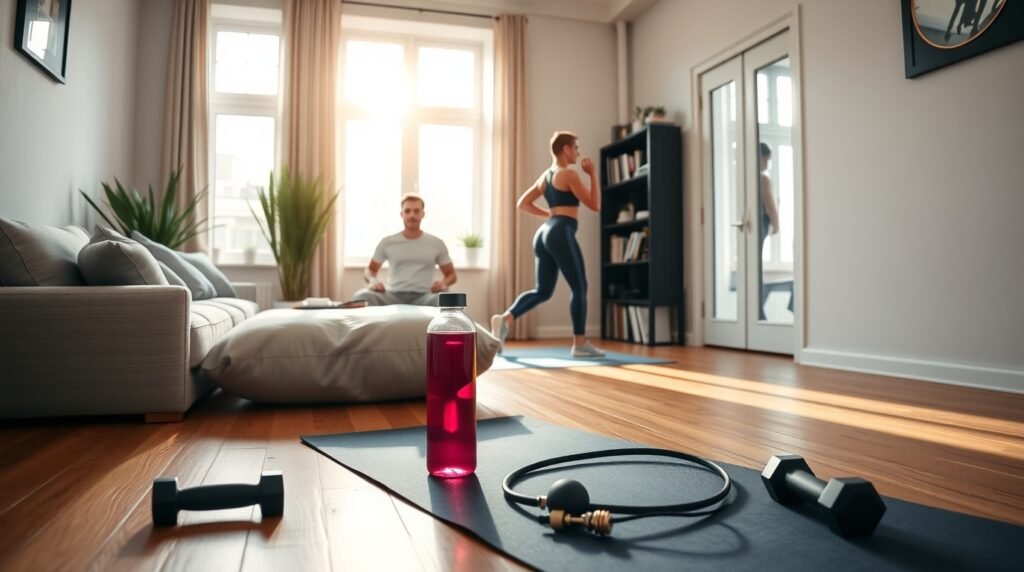
Best Cardio to Lose Belly Fat at Home: What Types of Workouts Are Super Effective?
Want to lose weight more easily at home? Cardio is a game-changer when it comes to weight loss. They push up your heart rate, ramp up your metabolism and help you burn calories efficiently. Learn about these quick exercises to lose fat fast and effectively, keeping you smiling during your workouts.
Jumping Rope: A Fun Workout!
Skipping rope is a great cardio exercise that can burn off the pounds in no time. Not only does it get your heart rate up, but it also challenges coordination and works your lower body. Shoot for at least 10 to 15 minutes of uninterrupted jumping to get the greatest fat-burning payoff. You can shake this up with intervals, mixing in faster paces before backing off for recovery to keep your body guessing.
High-Intensity Interval Training (HIIT)
Hiit is of the best cardio for weight loss at home. This routine alternates between brief, vigorous bursts of exercise and recovery periods. Here’s a beginner H.I.I.T. workout you can try:
- Jump Squats: 30 seconds
- Rest: 30 seconds
- Burpees: 30 seconds
- Rest: 30 seconds
- Mountain Climbers: 30 seconds
- Rest: 30 seconds
- Repeat: 3 to 5 times
HIIT workouts can boost fat burning and enhance cardiovascular health, especially when performed few days a week.
Dance Workouts
Who says cardio has to be boring! It is a fun way to get some exercise, help yourself lose weight and tone up your body. Dancing Whether it’s Zumba, hip-hop or just a dance party in your living room, getting down moves pretty much every part of your body and won’t make you want to give up. A 30-minute dance workout can burn anywhere between 200 and 400 calories, but the key to losing weight is (I’m going to keep saying it) maintaining intensity.
Bodyweight Exercises
You can crush strength training and cardio in one with bodyweight workouts. A bunch of exercises, such as jumping jacks, lunges and push-ups can be done in a circuit to get your heart rate pumping. Try this circuit:
- Jumping Jacks: 1 minute
- Push-Ups: 1 minute
- High Knees: 1 minute
- Plank: 30 seconds
- Rest: 30 seconds
- Repeat: 3 to 5 times
This kind of workout can help you gain muscle and make progress with your cardio, which is a win-win if you’re looking to lose weight.
Running or Jogging in Place
If you’re space-restricted, doing work in place can provide a great cardio exercise. You can listen to music or watch your favorite TV show and do this. Attempt at least 20-30 minutes at a consistent pace. Add some variety in there with high knees or butt kicks to keep it interesting and challenging.
Cycling
You also may want to cycle as a way to get your cardio and burn calories. Have a stationary bike at home? Keep pedaling for weight loss. Shoot for 30 minutes to 45 minutes of steady cycling or change it up between high resistance and low resistance for a HIIT effect. And don’t miss to set the seat height correctly, for an amazing workout!
Kickboxing
Kickboxing is a high-energy cardio routine that fuses martial arts, and provides a full-body or core workout! No fancy equipment required; you’re good with gloves or some soft punching bags. Give a 20-minute kickboxing workout that involves punches, kicks and footwork a shot to get the most out of your potential for fat burning.
Adding these quick workouts to your routine can help you reach your weight loss goals at home. Try a variety of workouts to see which you enjoy the most. And of course, don’t forget to be consistent and complement these exercise routines with a balanced diet. You have the ability to change your physique, so let’s do this–and have fun on our fitness journey!
The Science Behind Cardio and Fat Burning: How It All Works

If you’re trying to shed some pounds, knowing the science behind cardio and fat burning can be as essential as actually doing the work. Cardio workouts are frequently one of the topics that come up when you’re trying to lose weight and get healthy. So, how exactly does this process work? Now we’re going to get into the nitty gritty of cardio, and how it works for fat loss.
Understanding Energy Expenditure
Your body needs energy to work, and it gets that energy from calories in the food you eat. If you want to lose weight, you have to burn more calories than you consume…. Type of cardio, whether brisk walking or cycling or high-intensity interval training, raises your body’s calorie burning during and after workouts.
Types of Cardiovascular Exercise
There are many different types of cardio which come with their own sets of benefits. Here are some common forms:
- Constant Cardio: Everything from a brisk jog to cycling at an even pace. It works for stamina and fat-burning across longer periods.
- High-Intensity Interval Training (HIIT): With HIIT you have small amounts of very intense work followed by a short recovery. And this approach may elevate calorie burn and metabolic rate even after the workout ends.
- Low-Impact Cardio: Swimming or using an elliptical machine can be better on the joints, and ideal for those recovering from an injury or with mobility issues.
The Role of Heart Rate
The more calories you burn while performing cardio, the closer to your maximum heart rate (MHR) is achieved indicates how much fat the workout burns. As a general rule, seek to get 60%-85% of your maximum heart rate in order to maximize fat loss. You can estimate your maximum heart rate by subtracting your age from 220. Strap on a heart rate monitor to know when you’re in the fat-burning zone.
Fat Oxidation Process
When you do cardio, your body burns both fat and carbohydrates for fuel. In lower intensity exercise, your body burns a greater proportion of fat; in higher-intensity workouts, it turns to carbohydrates. This is what’s called fat oxidation.
In other words the body shifts to fat oxidation as exercise duration increases. As you become more fit, your muscles improve their ability to use fat during exercise, a quality that can help increase the amount of fat burned with each session.
The Afterburn Effect
And you may have heard of the “afterburn effect,”or Excess Post-exercise Oxygen Consumption (EPOC). After high-intensity workouts, for instance, your body still burns calories at a high rate after you’ve stopped exercising. This “thermogenic effect” can remain elevated for hours, if not even longer, and make up a large portion of total calorie consumption and fat lost. HIIT workouts are really good for gaining this benefit.
Consistency is Key
While knowledge of the science is important, it’s all about consistency when it come to enjoying the results of cardio for weight loss. Strive to perform 5 steady-state and high-intensity workouts each week. For optimal results, start with lower workout times and intensities, then work up over time.
Resistance training is also crucial, as it can help you burn fat by building muscle, which burns more calories at rest than fat. A little exercise and healthy eating every day is a more realistic approach that will guarantee slower but healthier weight reductions.
The Final Takeaway
When you know your body’s fat-burning switches, it becomes easier to maximize your workouts for better weight loss results. Mix that in with some cardio types, ‘cardioing’ your HR and using frequent moving to burn off fat and accomplish fitness endeavors. And always remember, it’s not just about the number—quality and balance within your fitness routine will produce the best results.
A Sustainable Home Workout to Lose Weight

Building a sustainable home workout routine for weight loss does not have to be super complex or scary. You can however start to see results by employing some smart strategies and a few effective exercises as part of your daily routine. Instead, focus on building a routine you enjoy and can maintain. Here’s what you need to do to get it going on the right foot.
Identify Your Goals
Begin by considering what you are hoping to achieve with your workout routine. Are you looking to slim down, pump up or just stay healthy? Clear goals keep you on track and motivated. Here are a few weight loss goals:
- Lose 1-2 pounds per week.
- Run a mile nonstop.
- Do 300 minutes of exercise each week.
Create a Weekly Schedule
Another important factor when trying to establish a sustainable routine is consistency. Plan your workouts for the week ahead of time, and treat them as appointments you can’t miss.Here’s a sample plan you could follow:
- Monday Cardio : 30 minutes of jumping jacks or jogging in place.
- Tuesday Strength training : bodyweight exercises, including push-ups and squats.
- Wednesday: Active recovery (easy walk, yoga)
- Thursday: High-Intensity Interval Training (HIIT) – Work in phases of 20 minutes between high and medium levels of workout.
- Friday: Full-body workout a combination of cardio and strength exercises.
- Saturday: Dancing or another fun activity something you enjoy that gets you moving.
- Sunday: Rest day or restorative yoga.
Choose the Right Exercises
Include a range of exercises for different sets of muscles. Pairing cardio and strength training can also help you get the most out of fat loss. Here are some home exercises that could be effective:
- Burpees
- High knees
- Mountain climbers
- Bodyweight squats
- Plank holds
You should try to complete different exercises each week so it doesn’t get boring. Mixing things up can help keep the excitement high and your body trying new variations for adjustments.
Find Your Motivation
Did my best to stay motivated and keep working out. Here are some tips to maintain your energy levels:
- Partner up with a friend or relative and hold one another accountable.
- Establish small rewards for meeting certain milestones (like some new workout clothes or a massage).
- Find fitness challenges or communities online for motivation and encouragement.
And remember, it’s all about finding what inspires you and possible for helping keep your eye on the prize.
Track Your Progress
Ultimately you need to see progress in order to understand how you’re doing. This way you can go back and revisit your workouts, changes in weight and how you feel after each session. It provides you a measure of success and where you may want to adjust if at all.
Focus on Nutrition
For weight loss, the role of your diet is very critical. Combine that with healthy eating habits at home. To get going, here are a few straightforward tips:
- Keep yourself well-hydrated with water.
- Concentrate your intake on whole foods such as fruits, vegetables, lean proteins and whole grains.
- Steer clear of sugar drinks and too much nibbling at processed foods.
Paying attention to what you put into your body will help keep your fitness goals on track and get even better results.
Listen to Your Body
listen to what your body is telling you. If something doesn’t feel good or hurts, change the exercise or rest. Recovery is just as important in an exercise program and there’s nothing wrong with resting when necessary! It will help prevent injury, and give you sustainable progress.
With these tips in mind, you should be able to establish a sustainable home workout routine that is suitable for you, helps with weight loss and one that does not demotivate. And remember, the best routine is one you can consistently follow and enjoy for the long haul.
Conquering Common Home Cardio Workout Hurdles

Home cardio workouts are an ideal way to get and keep fit — particularly when you can’t make it to the gym. But a lot of folks run into issues that can render those workouts less efficient, or even keep them from wanting to continue with their routines. The first step in addressing these shared issues is identifying them, so you can overcome them and make sure your home cardio workouts are working for you.
One significant challenge is space. Most people don’t have a workout room, and that creates clutter, frustration, while working out. To counteract this, dedicate an area in your home to be used for working out. Some cardio workouts don’t require much real estate. You may define this space with mats, cushions or even furniture. Keep it inviting by maintaining a neat appearance and displaying your most inspiring quotes or images.
Another common problem is having no incentive. Exercising at home can be less engaging than a group setting. To maintain your energy do not forget to add some variety to your cardio program. In addition, you can add other different exercises such as dancing or jogging in place, jumping rope and high level interval training (HIIT). Time yourself and push through brief intervals of activity followed by rest periods. It is a fun twist and can help keep you going.
Time management presents another hurdle. It can be tough to find time to exercise when you’re juggling work, family and other obligations. To counter this, plan your workouts on par with scheduling an important meeting. You don’t need an entire hour to get a great workout. Even if you carve out 20-30 minutes of dedicated focus on cardio. Try to select times when you’re least likely to be disturbed, be that early in the morning or late in the evening.
For some, it’s all about accountability when working out at home. Without a trainer or workout buddy to offer accountability, it’s all too easy to skip workouts. Try and keep yourself accountable somehow; whether that is using online fitness groups, starting a social media challenge or getting friends/family involved. Sharing your journey can help hold you accountable and help you feel more motivated to keep up with those workouts.
Equipment is another common obstacle. Your cardio workouts could be impacted by lack of access to gym equipment. But you don’t need fancy equipment to get your heart racing. Calisthenics moves, like burpees, mountain climbers and jumping jacks, are effective cardio exercises that can be done on their own or made part of a circuit anywhere you see fit. If you would like to add resistance into the mix, a resistance band or pair of dumbbells (they’re often relatively cheap and can handle countless exercises) is worth an investment.
Do not underestimate the psychological gain of a reasoned plan. It’s hard for a lot of people to know just what they should be doing and how much progress they should strive for. To correct this, print up a basic schedule of your cardio exercises throughout the week. You can also download apps for workouts — some come with plans and even video demos of offerings like circuit cardio. That way in actual workout time, you can focus on executing not planning.
- Space Solutions Set aside a clear area to work out.
- Increasing Motivation: Mix up your workouts on a regular basis.
- Time Saver: Break a sweat with these high intensity training session in 30 minutes or less.
- Seek accountability: Reach out to friends or online communities.
- No Gears Needed: Do the body exercises, no need to use any equipment.
- Planned Structure: Refer to workout plans.
And if you do, keep in mind it’s the long game that counts and all these little bits add up to something big alongside your quest for fitness. Whether you can sneak in 15 minutes on a busy day or indulge longer when you have the time, the important thing is that that you’re always making progress.
Tracking Your Progress – How Much Weight Can You Lose From Home Workouts?

You need to monitor your progress during at-home workouts if you want to lose weight. Without proper measurement, it’s difficult to know if anything is changing and that can get frustrating. By monitoring a few key indicators, you can celebrate your wins and tweak your strategy when need be. Here’s what you should be paying the most mind to when you assess your weight loss progress from at-home workouts.
Regular Weight Checks
Hopping on the scale regularly is one of the basic ways to measure progress. Choose a certain time of day once a week — say, Sunday mornings. This may help to smooth out daily fluctuations due to hydration or changing food intake. Use a good scale for repeatable results.
Body Measurements
The whole story isn’t always told by the scale. Measuring your body to track physical changes that a scale might overlook can also be helpful, so grab a measuring tape and jot down the following:
- Waist circumference
- Hip circumference
- Chest circumference
- Thigh and arm measurements
By recording these areas monthly, you can see that you are losing fat even if your weight isn’t changing much.
Progress Photos
Visuals work to track transformation – it’s scientifically proven. It may help you maintain your motivation if you’re able to see visible alterations in your body through “before” and “after” photos. Try to return to the scene of the crime, or at least try taking your shot at a similar angle in similar lighting each month. It also will enable you to detect muscle toning or fat loss, which is not always visible as it happens day by day.
Fitness Levels
Make sure you push yourself by monitoring your fitness levels over time to see how much stronger and faster you’re getting. Recording to Monitor Your Progress You can monitor your performance by recording:
- No of repetitions in a particular exercises
- Time limit of a workout, for example cardio(pdev)
- How much weight you can lift
If you find that you’re able to do exercises more easily, or if you are lifting heavier weights, it’s a great indicator of progress.
Energy and Mood Improvement
One measure of success that is often overlooked: how you feel. As you’re doing home workouts, tune into your energy and mental well-being. Many of us feel better, both in our mood and our energy levels, when we exercise regularly —which can be just as vital as losing weight on the scale.
Just record how you feel before and after exercise in a simple journal. Over the weeks, you’ll identify rhythms that emphasize your emotional and physical gains.
Caloric Intake Tracking
The foods you eat impact the amount of weight you lose. Apps or a food diary can help you to keep tabs on what you eat. This can help keep you aware of the number of calories and nutrients your body is getting, so you’re able to properly fuel up for your home workouts. It is another way to monitor your food, and see if what you ate had anything directly related to how you did in the gym.
Consistency and Routine
If so, you could be in luck as consistency may be the key to unlocking success. Record your workout dates, and shoot for 3-5 sessions/week. Consistency is key to keeping it moving. If you see weaknesses in your resolve, jot them down and reflect on what inspired you to begin with to regain your focus.
So when you’re measuring your weight loss results from doing home workouts, do a combination of the following tracking types. This well-rounded perspective offers a truly holistic view of your journey. Remember, it is not only the numbers, but how great you feel, and how much energy you have and get stronger. As you monitor, adapt your routine accordingly and always reflect on all that you’ve managed to do, no matter its size. Every step is a progress towards your ultimate dreams!
Conclusion
Including some cardio in your at-home fitness routine is a proven way to lose weight and improve general health. When you know how you’re burning fat with cardio, you can get the most out of your workouts. Whether you’re choosing high-intensity intervals or steady-state workouts, the important thing is finding activities that speak to you and can be easily incorporated into your routine.
Getting into a solid workout routine is vital in the long run! Begin by establishing achievable goals and mixing up workouts to keep it fun. This does not only enforce consistency, it also makes the job more fun. “Of course,” remember, this weight loss journey is not all about cutting calories: it’s about developing a lifestyle that favors movement and enjoyment.
Obstacles like no time pressures etc may be usual, but they can be solved with some hints. Cultivating a supportive environment, whether in the form of a virtual group or workout buddy system can help increase buy-in and level of accountability.
And of course, don’t forget to monitor your own progress. Tracking success on a regular basis, no matter how small, can offer motivation as well as give you an idea of whether and how your workouts are helping with weight loss. Take time to celebrate those victories and keep the momentum going.
In the end, cardio for weight loss at home can achieve incredible results. Make the commitment, adjust to changes and watch your body take shape while you reach your targets for fitness! You are all set to conquer, your destiny is your action motivator and Zou will see the results in every workout that you do at home.